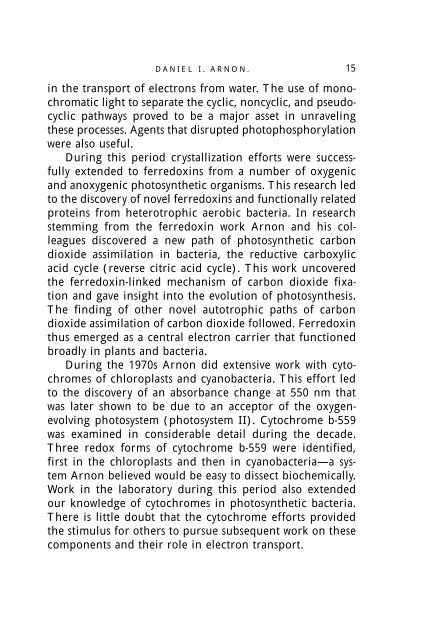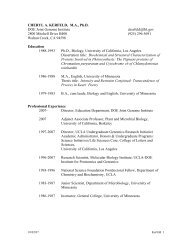DANIEL I ARNON 1910–1994
80 arnon - Department of Plant & Microbial Biology
80 arnon - Department of Plant & Microbial Biology
- No tags were found...
You also want an ePaper? Increase the reach of your titles
YUMPU automatically turns print PDFs into web optimized ePapers that Google loves.
<strong>DANIEL</strong> I. <strong>ARNON</strong>.<br />
in the transport of electrons from water. The use of monochromatic<br />
light to separate the cyclic, noncyclic, and pseudocyclic<br />
pathways proved to be a major asset in unraveling<br />
these processes. Agents that disrupted photophosphorylation<br />
were also useful.<br />
During this period crystallization efforts were successfully<br />
extended to ferredoxins from a number of oxygenic<br />
and anoxygenic photosynthetic organisms. This research led<br />
to the discovery of novel ferredoxins and functionally related<br />
proteins from heterotrophic aerobic bacteria. In research<br />
stemming from the ferredoxin work Arnon and his colleagues<br />
discovered a new path of photosynthetic carbon<br />
dioxide assimilation in bacteria, the reductive carboxylic<br />
acid cycle (reverse citric acid cycle). This work uncovered<br />
the ferredoxin-linked mechanism of carbon dioxide fixation<br />
and gave insight into the evolution of photosynthesis.<br />
The finding of other novel autotrophic paths of carbon<br />
dioxide assimilation of carbon dioxide followed. Ferredoxin<br />
thus emerged as a central electron carrier that functioned<br />
broadly in plants and bacteria.<br />
During the 1970s Arnon did extensive work with cytochromes<br />
of chloroplasts and cyanobacteria. This effort led<br />
to the discovery of an absorbance change at 550 nm that<br />
was later shown to be due to an acceptor of the oxygenevolving<br />
photosystem (photosystem II). Cytochrome b-559<br />
was examined in considerable detail during the decade.<br />
Three redox forms of cytochrome b-559 were identified,<br />
first in the chloroplasts and then in cyanobacteria—a system<br />
Arnon believed would be easy to dissect biochemically.<br />
Work in the laboratory during this period also extended<br />
our knowledge of cytochromes in photosynthetic bacteria.<br />
There is little doubt that the cytochrome efforts provided<br />
the stimulus for others to pursue subsequent work on these<br />
components and their role in electron transport.<br />
15




